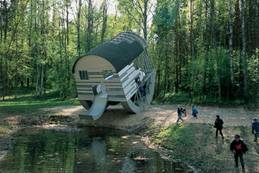
A MUSEUM SET IN NATURE | VISITOR INFORMATION | NEWS | THE COLLECTION | THE SCULPTURE OF TV SETS | EDUCATION | CONFERENCE HALL | SPACE FOR EVENTS | RESTAURANT | SHOP | POST OFFICE | CERTIFICATE | ARTIST RESIDENCY PROGRAM | HISTORY | SUPPORT | ARTICLES
|
Dennis Oppenheim. Chair/Pool
 Dennis Oppenheim. Drinking Structure with Exposed Kidney Pool
Dennis Oppenheim. Drinking Structure with Exposed Kidney Pool, detail
|
DENNIS OPPENHEIM |
||
|
The famous conceptualist Dennis Oppenheim (born 1938,) is one of the most outstanding figures of contemporary art. Oppenheim has been a pioneering artist in conceptualism, land art, body art, video, and sculpture since the late 1960s.
At the beginning of
his career, Dennis Oppenheim joined the Land Art Movement, and together with
Walter De Maria and Robert Smithson, sought for inspiration in fields and vast
spaces far from city noise. The Annual Rings on ice, made by Oppenheim on
the bank of the River Jones, are being reproduced by almost all art history
publications. Chair/Pool, the first work by Dennis Oppenheim in Europos Parkas, was built in 1996. The giant chair is made of about 300 metres of rolled steel pipe, 100 square metres of steel mesh, and contains more than 2 tons of water. Chair/Pool is one of the favourite sculptures among visitors of the museum.
Drinking
Structure with Exposed Kidney Pool - the second sculpture by Dennis
Oppenheim built at Europos Parkas. 10 metres high, 10
metres long and 5,5 metres wide, “the drinking structure” is shaped like a house
with corrugated roofing. The front of the structure represents its face. Two
parallel welded steel tunnels form arcs which theoretically allow the structure
to rock, and the front portion to dip down steeply to reach the water. Looking
at the structure as a living body, one can even imagine how a steel trough, or a
tongue, supplies this structure with water. Leaning towards one side, the structure like a house on springs seems to embody the worries of contemporary man, his feeling of instability. The words of art critic Manuela Gandini, “the work of art is not something to be looked at, but a means to see”, perfectly defines Oppenheim’s creation. This artist wordlessly initiates a philosophical discourse with his audience, fuelling unlimited possibilities of imagination. |